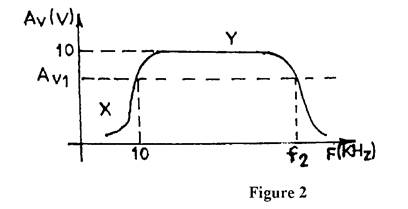Question 5
- Define the following amplifier types with respect to input-output cycle relationship:
(i) class A;
(ii) class B.
- Figure 2 is the frequency response curve of a transistor amplifer with a bandwidth of 90 kHz.

Calculate the:
(i) half power gain (Av1);
(ii) upper cut-off frequency (f2);
(iii) identify the region labelled X and Y.
Observation
The expected answers were:
- In terms of the input-output cycles’ relationship
(i) a ‘Class A’ amplifier is one, for which there is an output for the entire cycle of the input signal
(ii) and the ‘Class B’ is one for which there is an output only for half the input cycle.
- (i) Voltage gain at the ‘half-power’ point is determined as

NOTE: ‘Gain’ by definition, is a dimensionless quantity; and may refer to voltage, current, or power gain. For amplifiers, frequency response is typically with reference ‘power gain’, so that at the half-power points, gain is given by
 , which in this case, would be 7.071
, which in this case, would be 7.071
(ii) The upper cut-off frequency is given by

(iii) The region labelled ‘X’ is the ‘low frequency region’ of the response, and that labelled ‘Y’, the ‘mid-frequency region’ of the response.
Question 5 required candidates to define different amplifier types with respect to their input-output cycle relationship in the first task while the candidates were expected to study a frequency response curve to calculate its parameters in the second. The Chief Examiner reported that majority of the candidates that attempted this question did not respond well.
